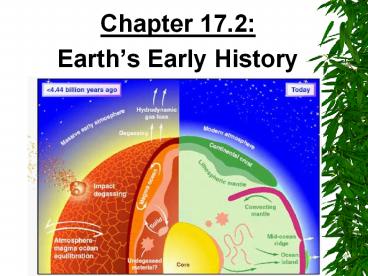Earth - PowerPoint PPT Presentation
1 / 15
Title:
Earth
Description:
Chapter 17.2: Earth s Early History Age of the Earth It is estimated that the Earth is 4.6 billion years old Theories of how the Earth was born vary (IE ... – PowerPoint PPT presentation
Number of Views:240
Avg rating:3.0/5.0
Title: Earth
1
- Chapter 17.2
- Earths Early History
2
Age of the Earth
- It is estimated that the Earth
- is 4.6 billion years old
- Theories of how the Earth was born vary (IE
the Big Bang Theory) - Elements arranged themselves according to density
- ?Least dense make up the atmosphere, most dense
make up the core
3
Earths Early Atmosphere
- Earths early atmosphere probably contained
hydrogen cyanide, carbon dioxide, carbon
monoxide, nitrogen, hydrogen sulfide, and water - All toxic gases except the
- water
4
The Early Earth
- It wasnt until 4 billion years ago that the
first solid rocks formed - It wasnt until 3.8 billion years ago that the
Earth was cool enough to have liquid water - So this is when the first oceans formed
5
Formation of Organic Molecules
- Early atmosphere allowed the formation of organic
molecules - Did not have oxygen
- Would not form in todays atmosphere
- Oxygen is too reactive
- Bacteria would eat the molecules
6
Miller and Urey
- Stanley Miller and Harold Urey attempted to
answer what the - Earths early atmosphere and
- how life began
- Filled an enclosed flask with
- hydrogen methane, ammonia,
- and water to represent the
- atmosphere
- Passed electricity through
- this mixture
7
The Results
- Amino acids began to form after a couple days
- Extensions of their experiments have also shown
to make nucleotides - Scientists think that these were the first steps
to life
8
The First Cells
- Thought to have originated 200-300 million years
after oceans formed - Earliest cells called proteinoid microspheres
were created when organic molecules became
trapped in bubbles - ?Not alive but have some
- characteristics of living cells
9
Oxygen-Free Life Forms
- The first life forms are thought to have evolved
in oxygen free environments approximately 3.5
billion years ago - Photosynthetic organisms evolved
- in the oceans approximately 2.2 billion
- years ago
- ?Started pumping oxygen into the
- atmosphere
10
Rusty Oceans
- When oxygen mixed with iron in the water, the
oceans began to rust - The iron oxide sank to the bottom of the oceans
giving us the iron ore deposits that we use today
11
The Ozone Layer
- The ozone layer formed when oxygen began to
accumulate in the atmosphere - Created a poisonous atmosphere where most of the
organisms became extinct - Those that survived became the anaerobic
organisms that we know today or they evolved to
use oxygen
12
Endosymbiotic Theory
- Belief is that eukaryotes formed approx. 2
billion years ago - Prokaryotes moved into prokaryotic cells
- Created a symbiotic relationship
- One group was able to use oxygen to make ATP
- Mitochondria
- One group was able to use light to make sugars
- Chloroplasts
13
(No Transcript)
14
Evidence of the Endosymbiotic Theory
- Membranes of mitochondria and chloroplasts are
similar to that of free-living prokaryotes - Mitochondria and chloroplasts have
- DNA similar to bacterial DNA
- Ribosomes similar to those of bacteria
- Reproduce by binary fission
15
Sexual Reproduction
- The use of sexual reproduction by early organisms
allowed evolution to occur at a much quicker rate - More gene shuffling

